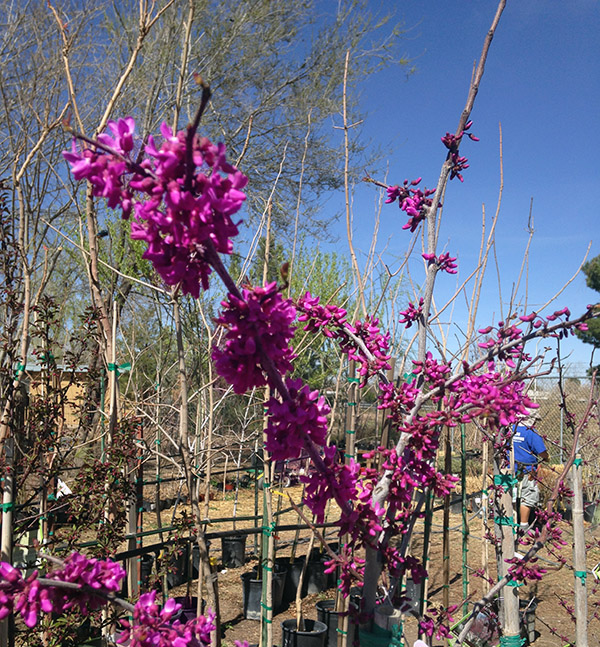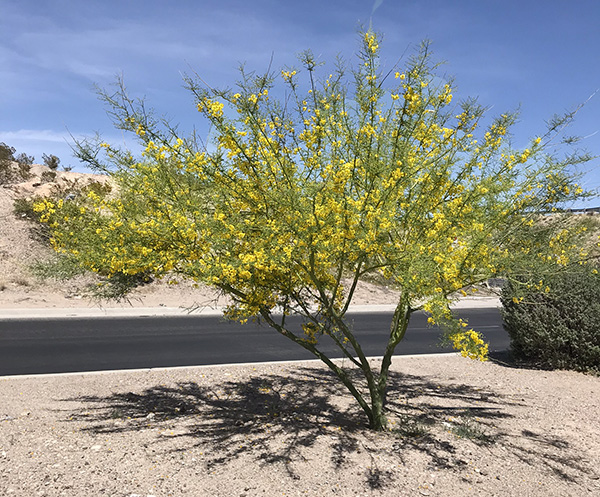
Southwest Trees
Trees for the Southwest U.S.A. You’d be surprised at the type of trees that will thrive in the desert southwest. These trees will do well in the lower elevations of the southwest. Most require little to moderate watering once they become established. Just click on the American Southwestern Tree photo for a larger image.
Las Cruces Trees – Pictures of trees taken in and around the southern part of New Mexico. Need to know your USDA plant hardiness zone? Click Here
We are the largest retail gardening nursery in Southwestern New Mexico. Come by and see our exclusive outdoor furniture and pottery.
Southwest Trees for Landscaping

The Afghan Pine
Scientific Name: Pinus eldarica
Full Sun: Full or partial shade – USDA Zone: 6 – 10
Afghan pine/Desert pine is a fast-growing evergreen tree and can be used as border landscaping. Can grow up to 80ft. tall and 30ft. wide. Trim the bottom branches for great shade during the summer months. Low water once established. Also called Mondell pine.
 Desert Willow Scientific Name: Chilopsis linearis
Desert Willow Scientific Name: Chilopsis linearis
Sun: Full Sun – USDA Zone 7 – 9
Desert willow grows to about 25ft tall. If you are looking to attract hummingbirds, then this is the tree to get. Beautiful light purple blooms very hardy shrubs or trees. Very drought tolerance once established. More Desert Willow Information
 Mesquite Tree/shrub Scientific Name: Prosopis glandulosa
Mesquite Tree/shrub Scientific Name: Prosopis glandulosa
Full Sun – USDA – Zone: 7 – 10
Mesquite has green foliage and is deciduous. Large sweet edible pods on branches. Very drought tolerant tree. Grows about 15-20ft tall and wide. It has large thorns and can be easily trained as a tree.
Scientific Name: Prosopis chilensis
Full Sun – USDA – Zone: 7 – 10
The Chilean Mesquite tree has green foliage and is deciduous. Unlike the Honey Mesquite, it has no thorns and grows larger. A very drought-tolerant tree. Grows about 40ft tall and wide. Darker Bark.
Click here for Chilean Mesquite for more information.
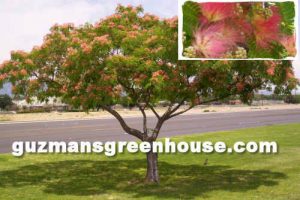 Mimosa or Silk Tree Scientific
Mimosa or Silk Tree Scientific
Name: Albizia julibrissin
Full Sun – USDA – Zones: 6b thru 9
The Mimosa tree can withstand droughts and produces beautiful pink spikes that bloom at the top. Can grow up to 30ft. tall and sometimes wider. Excellent canopy shade tree.
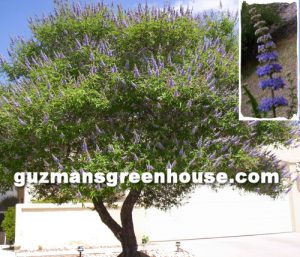 Vitex Scientific Name: Agnus-castusFull Sun – USDA Zones 6-10 The vitex tree or shrub. Also called the Chaste tree. Can grow to about 15-20ft. tall and wide. Drought tolerant once established. Beautiful spiky dark blue blooms late spring-early summer. More information about the Vitex Tree is Here.
Vitex Scientific Name: Agnus-castusFull Sun – USDA Zones 6-10 The vitex tree or shrub. Also called the Chaste tree. Can grow to about 15-20ft. tall and wide. Drought tolerant once established. Beautiful spiky dark blue blooms late spring-early summer. More information about the Vitex Tree is Here.
 Scientific Name: Quercus virginiana
Scientific Name: Quercus virginiana
Sun: Full Sun – USDA Zones: 7-10
Southern Live Oak – Can grow up to 80-100ft. Live oak is a long-lived, massive, evergreen shade tree. It has horizontal branches to form a broad rounded canopy. This tree loves full sun and is a moderate grower. Moderate water once established. Live oak tree information here
Scientific Name: Morus alba pendule
Can take Full USDA Zone 4-9
The weeping mulberry can grow up to 15-20ft tall, but not as wide. The tree forms a beautiful shade canopy. It’s a great ornamental tree for the front entrance. It provides shade all summer long. It is deciduous and easy to trim.

Scientific Name: Platanus acerifolia
Full Sun – USDA Zone 9a:
London plane trees can grow up to 100ft. tall and about 30-40ft wide. Large green leaf with pale white bark. The bark flakes will fall off, exposing white, smooth bark underneath. Excellent shade and ornamental tree.

Not really a tree but can be used as a border fence. The stems have large needle-like spikes. Want to keep pets or people from entering your space? This plant will do that job! Learn more about the Ocotillo plant.
Scientific Name: Fouqueiria splendens
Full Sun – USDA zone 8 & 7a – 7b. The Ocotillo is more of a shrub, not a real shade but has beautiful bright orange spring blooms. Green foliage in summer and grey in winter about 8-10ft tall. Once established they can survive with desert rain only.
Scientific Name: PUNICA GRANATUM Can be trained to grow into a small tree. It loves the full Sun – USDA zones: 6-9 Beautiful orange trumpet-like blooms in early spring. Good ornamental tree. This tree does produce large, sweet fruit. It will grow to about 25ft. tall and 15ft. wide. Deciduous in regions where there are freezing temperatures. Low water once established.
 Scientific Name: Robinia x ambigua requires full Sun – USDA zones 4 – 8 The purple robe Locust tolerates summer heat and dryness as well as the winter cold. This is a great tree if you want lots of filtered light. Perfect for planting small flowering shrubs. Beautiful fragrant pink flowers. Grows about 35ft. tall and 25ft. wide: good shade and ornamental tree.
Scientific Name: Robinia x ambigua requires full Sun – USDA zones 4 – 8 The purple robe Locust tolerates summer heat and dryness as well as the winter cold. This is a great tree if you want lots of filtered light. Perfect for planting small flowering shrubs. Beautiful fragrant pink flowers. Grows about 35ft. tall and 25ft. wide: good shade and ornamental tree.
Southwestern Chitalpa Tree Scientific Name:Chiltalpa tashkinensis
Full Sun – USDA zones 7-8 (roots are hardy to zone 6)
This tree grows to about 25 – 30ft. tall and wide. Beautiful pink all summer long blooms. Fast grower and very drought resistant. Another Southwest tree that lets lots of filtered light shine through.
There are some problems with this tree. Leaf drops, yellow spots, wilt, and more. Read more at the NMSU website.
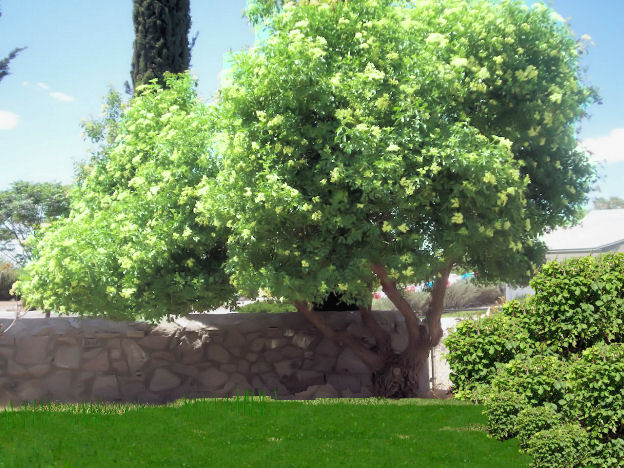 Scientific Name: Sambacus Mexicana
Scientific Name: Sambacus Mexicana
Grows to about 15-20ft tall and 15ft wide. Yellow blooms during the spring months.
Full Sun – USDA zones 7-8 (roots are hardy to zone 6) Commonly called the “Mexican Elder Tree”. This tree looks great during the spring months. The hot mid-summer heat will stress it out. A good tree to place in smaller landscape yards. More about the Mexican Elder tree.
Southwest Trees
California Christmas Tree Scientific Name: Cedrus deodara
Great looks evergreen tree. It is drought tolerant once established.
Needs occasional watering once established in the lower elevations of the southwest. Click the photo for more information. Full Sun – USDA zones 7-8 (roots are hardy to zone 6)
More information about this tree: California Christmas Tree
The Redbud Tree. A nice smaller tree that works well with smaller yards in the Southwest. The most common are Mexican, Oklahoma, and Western Redbud trees. USDA 7-9 zones. Full sun or partial sun. The Redbud will bloom in a dark lavender color flower. More info on Redbud trees is here. The Redbud Tree.

Weeping Willow Landscape – (Salix babylonica) A great tree for the Southwest. Lovely long flowing branches that weep towards the ground. It will grow about 50 ft. tall and 40 ft. wide. More about the Weeping Willow Tree Here.
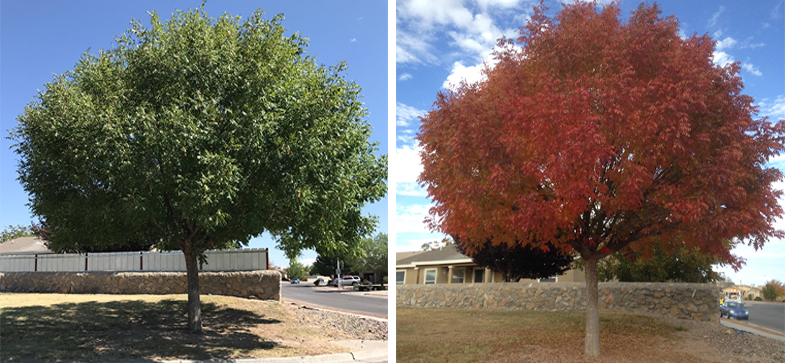
The Chinese Pistache (Pistacia Chinensis) is an excellent tree for the Southwest. The photo above shows the green summer look and, on the right, the dark bronze color during the fall season. Yes, it is the same tree in the same location. The only difference is the photo taken 3 months apart. More on the Chinese Pistache Trees.

The Palo Verde Tree (Parkinsonia aculeata) is a good tree for the Southwest. It produces bright yellow flowers in mid-spring and into mid-summer. A fast-growing tree about 35-40 ft. tall and wide. Plant in full sun will look great in rock landscapes. USDA zones 6-9. There is also the Desert Museum Palo Verde that comes from Monrovia thornless and produces fewer pods than the original species. Read more here.







